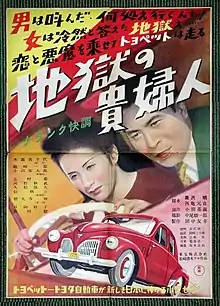Lady from Hell
Lady from Hell (Japanese: 地獄の貴婦人, Hepburn: Jigoku no kifujin), also known as The Infernal Trio,[1] is a 1949 Japanese drama film directed by Motoyoshi Oda. The film has been called a "protest movie" which "portrayed a cornucopia of corruption and indicted every known example of postwar exploitation: black-marketeering, crooked politicians, blackmailing journalists, and a decaying aristocracy."[2]
| Lady from Hell | |
|---|---|
 | |
| Directed by | Motoyoshi Oda |
| Produced by | Tomoyuki Tanaka Keiji Matsuzaki |
| Screenplay by | Akira Kurosawa Motosada Nishigame |
| Starring | Michiyo Kogure Eitaro Ozawa Takashi Shimura Michiyo Kogure |
| Music by | Ryoichi Hattori |
| Cinematography | Shunichiro Nakao |
Production company | Toho |
| Distributed by | Toho |
Release date | March 15, 1949 (Japan) |
Running time | 72 minutes |
| Country | Japan |
| Language | Japanese |
The script was written by famed Japanese director Akira Kurosawa.[3] Lady of Hell was regarded as one of Oda's best-known films.[4]
Plot
Inflation blows into the devastated land for three and a half years after Japan was destroyed and the reconstruction of the industry is slow. That is, the tax authorities have organized a "T-men" to detect tax evasion, which is the biggest cause of inflation, to balance the fiscal balance. The place is in front of the Fujimura Sangyo building. A group of "T Men" united with the police, Yoshioka, Kano, Mihara and others are inspecting the books in the office, but the double books in question are not available. Fujimura, the president of this company, comes in, but he laughs meaningfully and drives them back. However, Tachibana of the economic newspaper is persistently clinging to Fujimura. Meanwhile, Center Party executive Nango is in a romantic relationship with former Countess Mibu. Fujimura is also aiming for her. Nango and Fujimura have an inseparable connection of "gold." The relationship between political parties and Fujimura Sangyo began to gradually become entangled with Mrs Mibu, centred on "double books." It was newspaper reporter Tachibana who sensed this. He started searching for the whereabouts of the double books in cooperation with Yoshioka and others of "T Men", but the monster Fujimura does not reveal the evidence. Suddenly, reporter Tachibana went missing, leaving behind the news that he had grabbed a certain point. "T Men" and the police have begun a major action. Just as Fujimura and his friends, Nango, who is responsible for the fate of the Center Party, was suffering from money and women. Fujimura is willing to do whatever he thinks with the power of money. Finally, Fujimura takes Mrs Mibu out of Nango. To Atami, but Nango cannot give up on Mrs Mibu. Follow them to Atami, and follow them to "T Men". A group of police. Finally, the death of Tachibana's murder caused Fujimura to set foot and Nango and Mrs Mibu settled everything. The "T-men" muttered, "The future is important."
Cast
- Eitarō Ozawa as Fujimura
- Michiyo Kogure as Mrs. Mibu
- Akitake Kōno [5] as Tachibana
- Takashi Shimura as Inspection Department Manager
- Minoru Takada as Doi
- Shin Tokudaiji as Yoshioka
- Ichiro Ryuzaki as Nango
- Kinzō Shin as Kano
Production
After the Toho dispute, the newly launched unit pro, Keiji Matsuzaki , and Tomoyuki Tanaka's work will be directed by Akira Kurosawa and Motoyoshi Oda since the script "Tanuki Gentleman Appearance" by Yuanzhen Nishigame . Photographed by Shunichiro Nakao of "Underground Town 24 Hours" and "Spring Awakening" . Performers include Eitaro Ozawa from "Apostasy (1948 Keisuke Kinoshita)", Ichiro Ryuzaki from "Mrs. Suiren and the Rose Girl", and Michiyo Kogure from "The Fourth Lady" and "Aoi Sanmyaku (1949) ". of Akitake Kōno , of the "new wife conference" Shin Tokudaiji , of "woman of a lifetime (1949)," Takashi Shimura , Minoru Takada et al for Best Supporting. [6]
References
- "地獄の貴婦人(1949) : 作品情報". 映画.com (in Japanese). Retrieved 2020-09-20.
- Chapman, William (1991). Inventing Japan: The Making of a Postwar Civilization. Prentice Hall Press. p. 55. ISBN 0-13-942921-2. Retrieved 20 September 2020.
- Anderson, Joseph L.; Richie, Donald (2018). The Japanese Film: Art and Industry. Princeton University Press. p. 187. ISBN 9780691187464. Retrieved 20 September 2020.
- Ryfle, Steve (1998). Japan's Favorite Mon-star: The Unauthorized Biography of "The Big G". ECW Press. ISBN 9781550223484.
- Lady of Hell (1949), retrieved 2020-09-19
- "地獄の貴婦人(1949) | 最新の映画ニュース・映画館情報ならMOVIE WALKER PRESS". MOVIE WALKER PRESS (in Japanese). Retrieved 2020-09-20.
External links
- Lady of Hell on IMDb